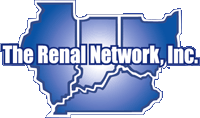2006 Annual Statistical Report
2006 ANNUAL STATISTICAL REPORT
FOR END-STAGE RENAL DISEASE NETWORK 9/10
THE RENAL NETWORK, INC.
Contract Numbers: HHSM-500-2006-NW 009C & HHSM-500-2006-NW 010C
June 30, 2006
Additional information and data tables are available in PDF format. Click on the link provided to view or download the selected section. Adobe Reader is a free plug-in and can be found at http://www.adobe.com/products/acrobat/readstep2.html.
- PREFACE
- President's Statement [PDF, 35.1KB]
- INTRODUCTION
- Network Description [PDF, 39.6KB]
- Network Structure [PDF, 73.5KB]
- CMS NATIONAL GOALS AND NETWORK ACTIVITIES
- Clinical Performance Measures Project [PDF, 25.9KB]
- Network 9/10 CPM Interventions [PDF, 129KB]
- CMS National CPM Project [PDF, 115KB]
- Network Special Projects/Studies [PDF, 215KB]
- Focused Quality Assurance Activities [PDF, 73.5KB]
- Special Study: Dialysis Treatment Delivered in the Nursing Home Setting [PDF, 20.5KB]
- Pilot Study: Barriers to Transplantation Project [PDF, 13.8KB]
- Resources & Opportunities for Beneficiaries [PDF, 34.9KB]
- Concerns & Complaints [PDF, 22.9KB]
- 2006 Formal Grievances [PDF, 19.6KB]
- Support & Mediation [PDF, 35.8KB]
- The ESRD Provider Community [PDF, 155KB]
- Nephrology Community at Large [PDF, 31.4KB]
- Compliance, Reporting, Tracking & Community Outreach
[PDF, 35.7KB]
- SANCTION RECOMMENDATIONS
- RECOMMENDATIONS FOR ADDITIONAL FACILITIES
- Recommendations
[PDF, 27.4KB]
- DATA TABLES
ESRD Network 9/10 shares a responsibility, along with the other 16 Networks throughout the United States, for achieving the goals of the Medicare ESRD Program. Network 9/10 continuously develops and implements quality improvement projects; each is designed to work toward these common goals to benefit the population of individuals with end-stage renal disease.
GOAL 1: Improving the quality and safety of dialysis related services provided for individuals with ESRD.
Improving quality and safety for care of ESRD beneficiaries was accomplished through clinical initiatives developed and supervised by the Medical Review Board and implemented by the Quality Improvement Department of The Renal Network, Inc. Quality is defined by the Institute of Medicine as: The degree to which health services for individuals and populations increase the likelihood of desired health outcomes and are consistent with current professional knowledge. These activities, designed to achieve the IOM quality definition, are categorized in five main subject areas:
GOAL 2: Improve the independence, quality of life, and rehabilitation of individuals with ESRD through transplantation, use of self-care modalities, in-center self-care, as medically appropriate, through the end of life.
ESRD Network 9/10 maintains a Patient Leadership Committee which works through the Patient Services Department to implement programs to benefit individuals with end-stage renal disease. Additionally, the Medical Review Board and the Board of Trustees each have four positions dedicated to patient representation to ensure the voice of the beneficiary is heard at every level of governance.
Through the efforts of the volunteers on these committees working through the Network staff, a variety of approaches to foster independence, encourage transplantation and self care, and improve quality of life for the individual with end-stage renal disease are ongoing. These include educational initiatives and activities to examine current methods in delivery of care, with an eye toward improving the current standards.
GOAL 3: Improve patient perception of care and experience of care, and resolve patient's complaints and grievances.
The Renal Network provides a voice for the ESRD Beneficiary through the grievance resolution process. Patients and family members may choose to discuss their issues with the Network staff. The Network staff works to resolve concerns as they are identified. With the patient's permission, staff members provide counseling and mediation to patients and dialysis facilities when conflict occurs. Patients may also choose to file a formal grievance. In this process, the complaint is officially addressed to the dialysis provider, and both sides of the issue are heard at the Medical Review Board level. The MRB makes the final determination in a formal grievance.
GOAL 4: Improve collaboration with providers to ensure achievement of the goals through the most efficient and effective means possible, with recognition of the differences among providers and the associated possibilities/capabilities.
Working in collaboration with other organizations creates synergistic strategies, and opportunities, which enable the Network to reach a diverse array of audiences with the common interest of improving quality of care for end-stage renal disease patients. During 2006, the Network collaborated directly with providers of end-stage renal disease services and with health care organizations in related areas. The goal of all of these activities was to benefit the ESRD patient by increasing knowledge and awareness of dialysis and transplantation.
GOAL 5: Improve the collection, reliability, timeliness, and use of data to measure processes of care and outcomes; maintain Patient Registry; and to support the ESRD Network Program.
No sanction recommendations were made during 2006.
The following tables are presented in PDF format.
- Facility Chronic Services Rendered By State and HSA for 2006 [PDF, 375KB]
- Actual Patient Load - Utilization by State and HSA for 2006 [PDF, 2.28MB]
- Dialysis Incidence, Prevalence and Patient Population by Modality and Treatment Option for 2006 [PDF, 3.85MB]
- Transplant Population Reports by State and Comparative Performance of Facilities and Providers for 2006 [PDF, 278KB]
Table 1: ESRD Incidence
- Network 9 [PDF, 36KB]
- Network 10 [PDF, 29.6KB]
Table 2: ESRD Prevalence
- Network 9 [PDF, 36.3KB]
- Network 10 [PDF, 29.8KB]
Table 3: Dialysis Modality, Home Care
- Network 9 [PDF, 44.9KB]
- Network 10 [PDF, 190KB]
Table 4: Dialysis Modality, In-Center
- Network 9 [PDF, 46.6KB]
- Network 10 [PDF, 162KB]
Table 5: Renal Transplant by Transplant Center
- Network 9 [PDF, 22.4KB]
- Network 10 [PDF, 18.7KB]
Table 6: Renal Transplant Recipients
- Network 9 [PDF, 31.6KB]
- Network 10 [PDF, 31.6KB]
Table 7: Dialysis Deaths
- Network 9 [PDF, 39.4KB]
- Network 10 [PDF, 31.9KB]
Table 8: Vocational Rehabilitation
- Network 9 [PDF, 245KB]
- Network 10 [PDF, 129KB]
